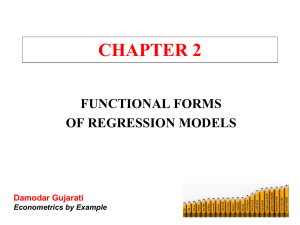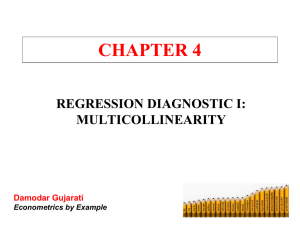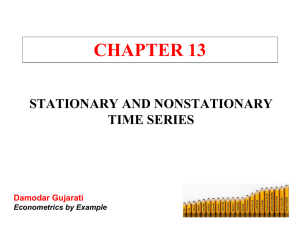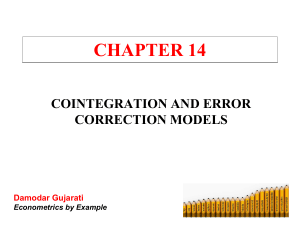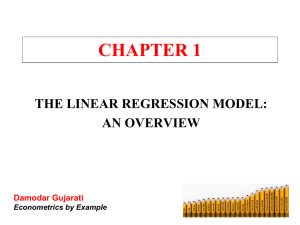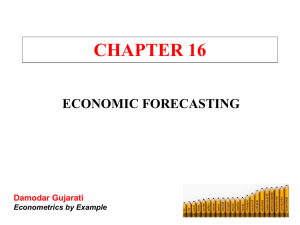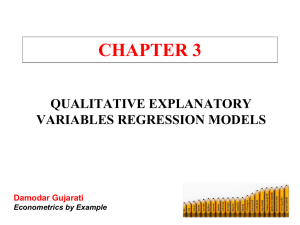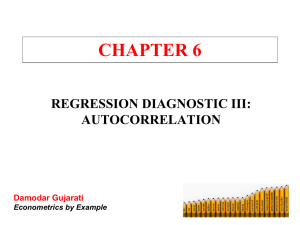Chapter 18 - Facultypages.morris.umn.edu
advertisement
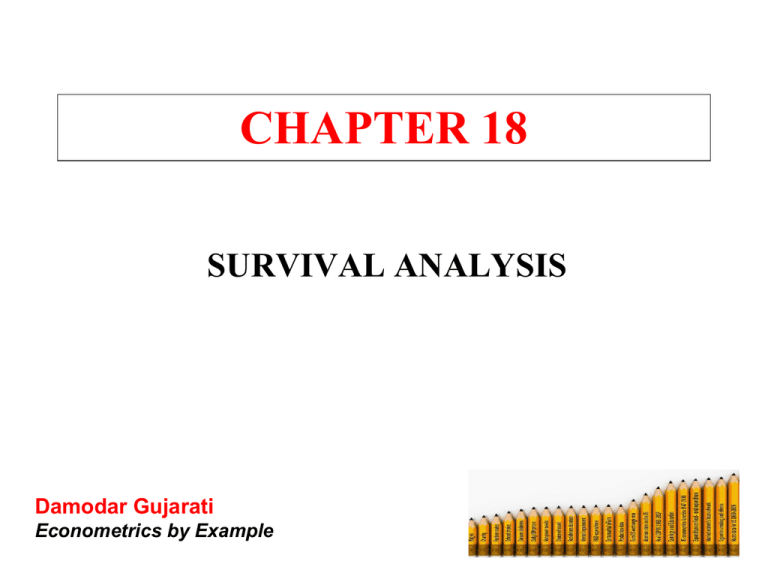
CHAPTER 18
SURVIVAL ANALYSIS
Damodar Gujarati
Econometrics by Example
SURVIVAL ANALYSIS (SA)
The primary goals of survival analysis are to:
(1) Estimate and interpret survivor or hazard functions from
survival data
(2) Assess the impact of explanatory variables on survival time
Survival analysis goes by various names, such as:
Duration analysis
Event history analysis
Reliability or failure time analysis
Transition analysis
Hazard rate analysis
Damodar Gujarati
Econometrics by Example
TERMINOLOGY OF SURVIVAL ANALYSIS
Event: “An event consists of some qualitative change that
occurs at a specific point in time….The change must consist
of a relatively sharp disjunction between what precedes and
what follows.”
Duration Spell: The length of time before an event occurs.
Discrete Time Analysis: Some events occur only at discrete
times.
Continuous Time Analysis: Continuous time SA analysis
treats time as continuous.
Damodar Gujarati
Econometrics by Example
CUMULATIVE DISTRIBUTION FUNCTION OF TIME
If we treat T, the time until an event occurs, as a continuous
variable, the distribution of the T is given by the CDF:
F (t ) Pr(T t )
which gives the probability that the event has occurred by
duration t.
If F(t) is differentiable, its density function can be expressed
as:
dF (t )
f (t )
F '(t )
dt
Damodar Gujarati
Econometrics by Example
SURVIVAL AND HAZARD FUNCTIONS
The Survivor Function S(t): is the probability of surviving
past time t and is defined as:
S (t ) 1 F (t ) Pr(T t )
The Hazard Function h(t): Consider the following function:
h(t ) lim
Pr(t T t h) T t
h 0
h
where the numerator is the conditional probability of leaving the initial
state in the (time) interval {t, t+h}, given survival up to time t.
The hazard function is the ratio of the density function to the
survivor function for a random variable:
h(t )
Damodar Gujarati
Econometrics by Example
f (t )
f (t )
1 F (t ) S (t )
SOME PROBLEMS ASSOCIATED WITH SA
1. Censoring: A frequently encountered problem in SA is
that the data are often censored.
2. Hazard Function With or Without Covariates: We
have to determine if covariates are time-variant or timeinvariant.
3. Duration Dependence: If the hazard function is not
constant, there is duration dependence.
4. Unobserved Heterogeneity: No matter how many
covariates we consider, there may be intrinsic heterogeneity
among individuals.
Damodar Gujarati
Econometrics by Example
SOME PROBLEMS ASSOCIATED WITH SA
There are several parametric models that are used in
duration analysis.
Each depends on the assumed probability distribution, such
as:
Exponential Distribution
Weibull Distribution
Lognormal Distribution
Loglogistic Distribution
Damodar Gujarati
Econometrics by Example
EXPONENTIAL DISTRIBUTION
Suppose the hazard rate is constant and is equal to h.
A constant hazard implies the following CDF and PDF:
F (t ) 1 e
ht
f (t ) F '(t ) he
ht
The hazard rate function is a constant, equal to h:
ht
f (t ) he
h(t )
ht h
S (t ) e
Damodar Gujarati
Econometrics by Example
WEIBULL DISTRIBUTION
If h(t) is not constant, we have the situation of duration
dependence—a positive duration dependence if the hazard
rate increases with duration, and a negative duration
dependence if this rate decreases with duration.
For this distribution, we have:
and
h(t ) t
1
; 0, 0
S (t ) e
Damodar Gujarati
Econometrics by Example
( ht )
PROPORTIONAL HAZARD MODEL
Originally proposed by Cox
The PH model assumes that the hazard rate for the ith individual
can be expressed as:
h(t | X i ) h0 (t )e BXi
where h0(t) is the baseline hazard
In PH, the ratio of the hazards for any two individuals depends
only on the covariates or regressors but does not depend on t, the
time.
The hazard rate is proportional to the baseline hazard rate for all
individuals:
h(t | X )
i
h0 (t )
Damodar Gujarati
Econometrics by Example
e BXi
SALIENT FEATURES OF SOME DURATION MODELS
Probability Distribution
Hazard Function
Survival Function
Exponential
h (t) = h
S (t ) e ht
Weibull
h(t ) t 1
S (t ) e( ht )
0, 0
Lognormal
f (t ) ( p / t )[ p ln(ht )]
S (t ) [ p ln(ht )]
Loglogistic
(ht ) 1
h(t )
1 t
S (t )
Damodar Gujarati
Econometrics by Example
1
1 ( t )
